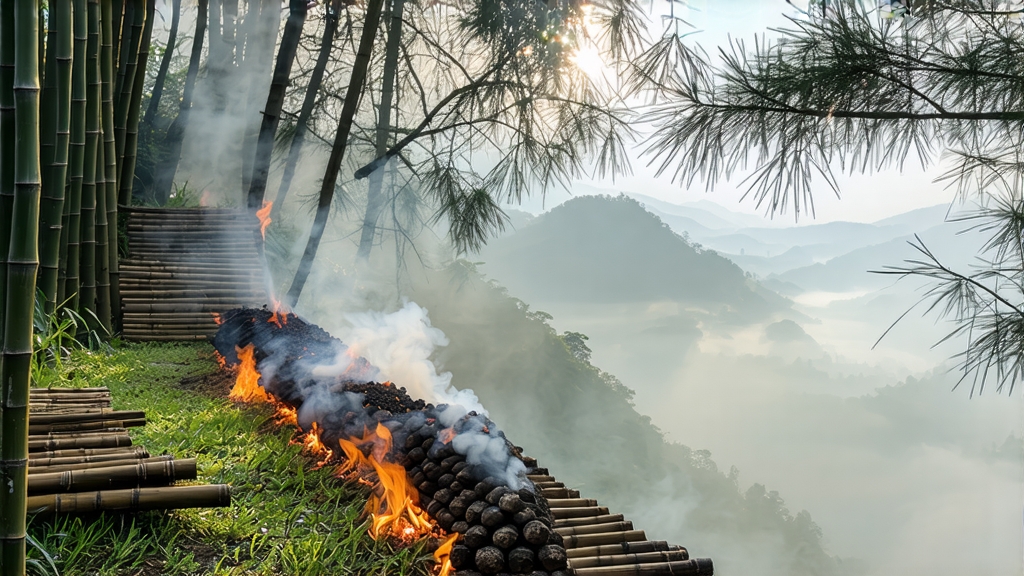
Long before the British coined the term “black tea,” caravans loaded with tightly rolled, pitch-black leaves left the granite gorges of northern Fujian. The year was 1646, Qing troops had just swept across the Wuyi range, and a desperate tea master decided to dry his freshly withered leaves over the nearest available fuel—fresh pinewood. The smoke penetrated the cellulose, the fire hurried the process, and the first fully oxidised, deliberately smoked black tea was born. Locals called it Zheng Shan Xiao Zhong—“small-leaf variety from the original mountain.” Dutch traders shortened the name to Lapsang Souchong, and by 1669 it was selling in Amsterdam for twice the price of green tea, igniting Europe’s two-century obsession with “bohea.”
Geography is the first secret. Only leaves picked within the 60 km² core of the Wuyi UNESCO reserve—between 600 m and 1 200 m on weathered tuff and sandy loam—may claim the protected designation Zheng Shan. Here, morning fog drifts up the Nine-Bend River, slowing photosynthesis and concentrating amino acids. The indigenous cultivar is a diminutive, slow-bushy plant known as Cai Cha (vegetable tea) whose leaves are barely 3 cm long yet bristle with downy serrated edges. Two sub-varietals have emerged since the 1990s: the traditional smoked style (Yan Xun) and the modern unsmoked “new craft” (Fei Yan), created for palates that crave the honeyed malt without the campfire note.
Craft begins the moment two leaves and a bud are snapped. Basket-loads are carried to the three-hundred-year-old Qing Lou (pine-smoke house) built entirely of fir without a single iron nail. Withering takes place on bamboo screens set over dying embers of local Masson pine; the temperature hovers at 28 °C for eight hours while artisans shuffle the leaves every twenty minutes to ensure even moisture loss. Rolling follows—first mechanical kneading for 45 minutes to rupture 80 % of the cells, then a 90-minute hand-roll that twists the leaf into the tight baroque curls that resemble a monk’s prayer beads. Oxidation is conducted in deep fir crates lined with wet cloth; the pile is turned every half hour so that the temperature never exceeds 32 °C, allowing theaflavins to bloom into a rose-copper liquor while preserving a touch of greener catechins for complexity. The critical smoking stage arrives at 3 a.m., when the pine-wood fire is at its most resinous. A double-tiered oven—upper rack for tea, lower pit for smouldering logs—infuses the leaf for six to eight hours. Master smokers judge readiness not by clock but by sound: when the crackle of resin subsides to a whisper, the tea has absorbed just enough terpene-rich vapours without turning acrid. Final baking over charcoal drops the moisture to 3 %, locking in the signature tarry sweetness that lingers like a violin’s last note.
To brew Lapsang Souchong is to conduct a miniature chamber concert. Begin with spring water whose TDS lies between 30–80 ppm; high mineral content mutes the subtle cocoa undertone. Pre-heat a thin-walled zisha or Jingdezhen gaiwan; the clay’s micro-porosity softens smoke while porcelain amplifies malt. Use 4 g of leaf for 100 ml, rinsed for three seconds to awaken the leaf and discard any surface ash. The first infusion, 92 °C for five seconds, yields a brilliant claret rim and a nose of pine balsam, dried longan, and a fleeting suggestion of leather. Subsequent steeps lengthen by three-second increments; by the fourth pour the liquor turns ochre, the smoke recedes, and a dark-honey sweetness emerges reminiscent of burnt sugar on crème brûlée. A well-crafted Lapsang will deliver six balanced infusions before surrendering its soul.
Tasting is a synesthetic exercise. Observe the “three reds and seven blacks” on the wet leaf—an old saying describing the ideal 30 % coppery edge and 70 % obsidian centre that signals flawless oxidation. Inhale with mouth slightly open; the cool air carries α-pinene